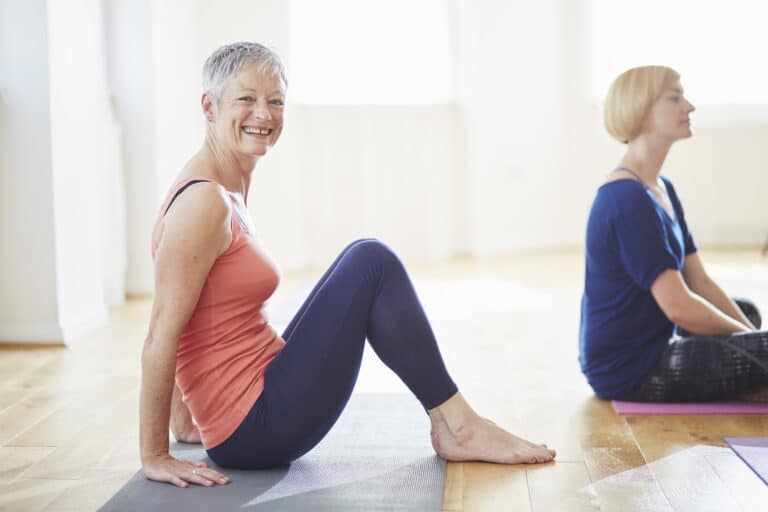There’s nothing quite like a good night’s sleep. But what happens when you wake up, ready to seize the day, only to be met with a sharp, restricting pain in your neck?
Morning neck pain can be a jarring way to start the day, hindering your ability to perform routine tasks, including turning your head to the side to look at your alarm clock. Let’s discuss ways to prevent and address this (literal) pain in the neck problem!
What Causes Morning Neck Pain?
Morning neck pain is a common complaint, especially among older adults. A study from the Journal of Pain Research indicates that up to 70% of adults aged 65 and over have experienced neck discomfort at some point.1
But why does this pain tend to strike in the morning? There are many reasons, which we will discuss in more detail below. However, one of the most cited reasons is that as we sleep, our bodies experience a decrease in blood flow, especially to areas such as the neck.
This reduction in circulation can cause stiffness and pain in the neck upon waking, especially if other contributing factors are at play.
Common Triggers for Morning Neck Pain
Several potential triggers for morning neck pain might complicate matters, and understanding these can be the first step toward relief. Common issues include less-than-ideal pillows or mattresses, awkward sleep positions, and underlying health conditions.
Humans spend at least a third of their day in the same position while sleeping, so you want to ensure you’re setting yourself up for success. Let’s explore some common culprits and how they might affect your neck health.

The Role of Your Bed and Pillows
While it may seem surprising, the pillow and mattress you choose can significantly impact your neck and spine health. If your pillow is too high or firm, it can put your neck at an unnatural angle, resulting in discomfort when you wake up. An optimal pillow can help support the natural curve of the neck, reducing strain and pain.1
If you’re experiencing neck pain, it might be time to reassess your pillow choice. A good pillow should align your neck with your spine, preventing unnecessary strain. It’s not about the fluffiest or firmest but what suits your sleeping style.
For instance, side sleepers might benefit from a firmer pillow. In contrast, back sleepers might find a medium-firm pillow more comfortable.
So, what exactly constitutes an optimal pillow? It supports your neck and head while aligning them with your spine. A pillow that is too high or too low could result in awkward sleeping positions that lead to muscle strain.
Sometimes, one pillow might feel too flat, but two pillows might be a little too high. In this case, try folding a towel and placing it under the pillow to functionally raise the height of the single pillow just a little, helping you find that sweet spot.
This may take a little trial and error, but finding out which bedding best suits your needs might save your neck in the long run.
Adjusting Your Sleep Position
Your sleep position can also play a vital role in the health of your neck. Sleeping on your stomach, for instance, can force your neck into an unnatural position for hours, leading to discomfort and stiffness.
According to the Journal of Physical Therapy Science, the optimal sleeping position for neck health is on your back or side. These positions help maintain a neutral spine and neck alignment, minimizing the risk of neck pain.2
It is crucial to optimize your sleeping position by getting a pillow and a mattress that complement it. If you are a side sleeper, you will likely need a softer mattress to allow your upper torso, shoulder, and arm to fall below pillow height and slightly sink into the mattress. You’ll want to support your head and neck by coupling this with a firmer, medium-height pillow.
If you are a back sleeper, you may prefer a firmer mattress and a pillow engineered explicitly for those who sleep on their back (maybe one with an indentation for your head). Getting proper support for the posterior neck while not pushing the head in too much flexion (i.e., making your chin too close to your chest) is also very important.
Back-sleepers may also benefit from a pillow under their knees to support their lower back and, in turn, the entire spine up to the neck.
Factors Beyond Your Sleeping Environment

Beyond pillows and sleep positions, other factors can contribute to neck discomfort.
Stress, for instance, can lead to muscle tension in the neck. Studies have found a significant correlation between stress and neck pain.3
Good posture is essential not only when you’re awake but also when you’re sleeping. Maintaining a neutral alignment can help prevent morning neck pain. This means your head, neck, and spine should be straight.
Be aware of how you hold your neck throughout the day, as poor daytime posture can contribute to discomfort at night. Maintaining good posture can help to reduce strain on the neck muscles, while poor posture can exacerbate neck pain. Improper posture can lead to neck strain, mainly when using electronic devices.
Let’s take a deeper look at some of these common daily triggers.
Simple Approaches to Manage Common Triggers
While morning neck pain can be a nuisance, it’s not something you have to simply put up with. In my years working with patients, I’ve seen firsthand how practical exercises and minor adjustments to bedtime routines can significantly improve morning discomfort.
By understanding and addressing the causes of morning neck pain, you can wake up ready to take on the day pain-free. Holistic approaches can also significantly help manage and prevent neck pain.
Stress Management
Have you ever noticed how your neck stiffens up after a stressful day? It’s not just your imagination—stress and emotional factors indeed play a role in causing neck pain. Psychological stress contributes to muscle tension and inflammation, potentially leading to neck pain (3).
Anxiety and stress can trigger your fight-or-flight reflex, and your body is in a constant state of trying to protect you by keeping tension in your muscles, especially those close to your head and heart.
So, next time you feel stressed, remember to take a moment to relax your shoulders from your ears and stretch your neck; your neck will thank you! Incorporating relaxation techniques such as mindfulness, yoga, and meditation into your daily routine can help you manage stress and reduce neck discomfort.
Ergonomics and Posture Adjustments
We live in a digital age, and while technology has benefits, it can also be a literal pain in the neck. Prolonged periods of looking down at smartphones and laptops lead to “tech neck,” a postural syndrome causing neck pain.4
To prevent ‘tech neck,’ ensure your electronic devices are at eye level, your shoulders are relaxed, and you’re taking regular breaks to move around.
Suppose you spend extensive time at a desk or in front of a computer for work. In that case, however, it’s worth investing in ergonomic furniture or adjusting your workspace.
An ergonomically friendly setup promotes good posture and reduces strain on your neck. Adjustments include a supportive computer chair with a headrest, lower back support, and a 90-100-degree angle at your hip joint.
Additionally, you want to keep your computer at eye level to maintain a neutral head position. A standing desk or walking desk would allow for dynamic movement and change of position to avoid excessive forward head posture.
Forward head posture can increase the weight of your head on your neck and upper body by 3 to 4 times, significantly increasing the stress on your neck.
If you spend much time sitting or looking at a screen, get up and move around regularly; your neck will thank you later.
Dietary considerations
A diet high in anti-inflammatory foods such as fruits, vegetables, lean proteins, and healthy fats can help manage inflammation, which can contribute to unnecessary pain.
Similarly, supplements like Omega-3 fatty acids and turmeric have been shown to have anti-inflammatory effects that can help alleviate neck pain. But remember, always consult with a healthcare professional before starting any new dietary changes or supplements.
Did you know that simply drinking water can help alleviate neck stiffness? Your discs, the cushions between your neck vertebrae, need water to maintain their shape and cushioning ability, which reduces pressure on the neck.
A study published in Orthopedics Clinics has shown that dehydrated discs can contribute to degenerative disc disease, a common cause of neck pain.5
Eating well provides numerous benefits, and good dietary habits might help to manage pesky morning neck pain.
Exercises to Prevent Neck Pain

Exercise is a critical component in managing and preventing neck pain. Regular exercise, particularly strength and flexibility exercises, can improve neck muscles’ strength, durability, and range of motion.
Individuals who engage in regular neck-specific exercises have significantly reduced neck pain (6). Always consult a health professional before starting a new exercise regimen.
Here are five sample exercises, along with descriptions for performing them, aimed at providing relief for morning neck pain:
Chin Tucks
- Sit or stand with your spine straight and shoulders relaxed.
- Gently tuck your chin towards your chest, focusing on lengthening the back of your neck.
- Hold the position for 5-10 seconds, feeling a stretch at the base of your skull.
- Repeat 10-15 times.
Neck Rotation
- Sit or stand comfortably with your spine straight.
- Slowly turn your head to the right, aiming to bring your chin over your right shoulder.
- Hold the position for 5-10 seconds, feeling a gentle stretch along the left side of your neck.
- Return to the center and repeat on the left side.
- Perform 5-10 rotations on each side.
Side Neck Stretch
- Sit or stand tall, ensuring your spine is straight.
- Reach your right arm toward the floor, anchoring it with your hand.
- Slowly tilt your head towards your left shoulder until you feel a stretch along the right side of your neck.
- Hold the stretch for 15-30 seconds, then switch sides.
- Repeat 2-3 times on each side.
Shoulder Rolls
- Sit or stand with your arms relaxed by your sides.
- Shrug your shoulders towards your ears, then roll them back in a circular motion.
- Continue moving your shoulders back for 10-15 repetitions.
- Reverse the direction and roll your shoulders forward for another 10-15 repetitions.
These exercises can help alleviate tension and stiffness in the neck muscles, promoting flexibility and mobility. They are particularly beneficial for individuals experiencing morning neck pain.
However, performing them gently and within your comfort level is essential to avoid exacerbating any discomfort. If you experience pain during these exercises, discontinue them and consult a healthcare professional.
Stretching and Yoga
Consider regular stretching or yoga if you’re looking for another noninvasive self-care method to prevent recurrent neck pain.
Yoga can be particularly beneficial, emphasizing posture, flexibility, and relaxation. Moving into different body positions and focusing on new postures that challenge your body’s resting alignment allows your neck and head support muscles to build strength in various planes.
Incorporating a few simple stretches or yoga poses into your daily routine can go a long way in keeping neck pain at bay.
Through exercise, it’s possible to effectively manage neck pain by understanding potential causes and implementing preventative measures. So, take action today and make those small lifestyle changes for a pain-free tomorrow!
A Real Patient’s Journey to Overcoming Morning Neck Pain
When Sarah, a 33-year-old female, walked into our physical therapy clinic, she carried with her the weight of weeks of morning neck pain. Her discomfort was palpable, but so was her determination to find relief.
Listening carefully to Sarah’s story, I learned about her daily routine and challenges. Together, we explored potential factors contributing to her neck pain.
How We Addressed Sarah’s Neck Pain
We strengthened Sarah’s neck muscles during our sessions and improved her posture. We found that she had recently switched jobs and moved to a new city, so we also discussed stress management techniques to help alleviate tension.
Sarah said she slept well but hasn’t been exercising as much lately because she is adjusting to her new schedule.
I advised Sarah on some targeted exercises, ensured she had the right pillow and mattress to suit her sleeping style, and discussed the importance of consistency with her new routine.
As time went on, Sarah began to experience improvements. The stiffness and soreness in her neck gradually diminished, and she woke up with less pain each morning.
The Results of Sarah’s PT for Neck Pain
With each session, Sarah grew more confident in managing her neck pain. By the time she completed her treatment, she had gained valuable tools to help her continue her journey to wellness.
She even told me that she had let a few friends know about the changes she made and how beneficial they were for her and that they would also look into making some changes in their lives.
Sarah’s experience reminds us of the importance of addressing morning neck pain early on and seeking professional guidance to find practical solutions. She could reclaim her mornings and live life with greater comfort and vitality through dedication and perseverance.
Follow Sarah’s lead by addressing your morning neck pain early the next time you wake up and can’t turn your head!
Summary:
Waking up to neck pain can significantly disrupt your day and routine. This discomfort, particularly prevalent among older adults, often stems from various factors, including poor sleep posture, inadequate support from pillows and mattresses, and underlying health conditions. Addressing these triggers through ergonomic adjustments, stress management, and targeted exercises can vastly improve your situation. The article explores practical solutions for overcoming morning neck pain, from choosing the right pillow and mattress to adjusting sleep positions and incorporating neck-specific exercises. By making these adjustments and being mindful of posture and stress levels, individuals can wake up feeling refreshed and pain-free, ready to tackle the day ahead.
Key Takeaways
- Morning neck pain often results from poor sleep posture and inadequate neck support.
- The right pillow and mattress reduce neck pain by maintaining proper spine alignment.
- Sleeping on your back or side is recommended to minimize neck strain.
- Stress and daytime posture significantly impact neck health, necessitating holistic management strategies.
- Targeted exercises and stretches can strengthen neck muscles and increase flexibility.
- Ergonomic adjustments to workspaces can prevent “tech neck” and reduce discomfort.
- Regular movement and breaks during sedentary activities help alleviate neck tension.
- A diet rich in anti-inflammatory foods and proper hydration can support neck health.
- Consulting a physical therapist can provide personalized strategies for managing neck pain.
- Small lifestyle changes, like adjusting sleep environments and managing stress, can significantly reduce morning neck pain.
References
- Gordon, S. J., Grimmer-Somers, K. A., & Trott, P. H. (2010). Pillow use: the behavior of cervical stiffness, headache and scapular/arm pain. Journal of pain research, 137-145.
- Lee, M. Y., Lee, H. Y., & Yong, M. S. (2014). Characteristics of cervical position sense in subjects with forward head posture. Journal of physical therapy science, 26(11), 1741-1743.
- Rissén, D., Melin, B., Sandsjö, L., Dohns, I., & Lundberg, U. (2002). Psychophysiological stress reactions, trapezius muscle activity, and neck and shoulder pain among female cashiers before and after introduction of job rotation. Work & stress, 16(2), 127-137.
- Park, J., Kim, J., Kim, J., Kim, K., Kim, N., Choi, I., … & Yim, J. (2015). The effects of heavy smartphone use on the cervical angle, pain threshold of neck muscles and depression. Advanced Science and Technology Letters, 91(3), 12-17.
- Roh, J. S., Teng, A. L., Yoo, J. U., Davis, J., Furey, C., & Bohlman, H. H. (2005). Degenerative disorders of the lumbar and cervical spine. Orthopedic Clinics, 36(3), 255-262.
- Kim, S. D. (2018). Effects of yogic exercise on nonspecific neck pain in university students. Complementary therapies in clinical practice, 31, 338-342.






